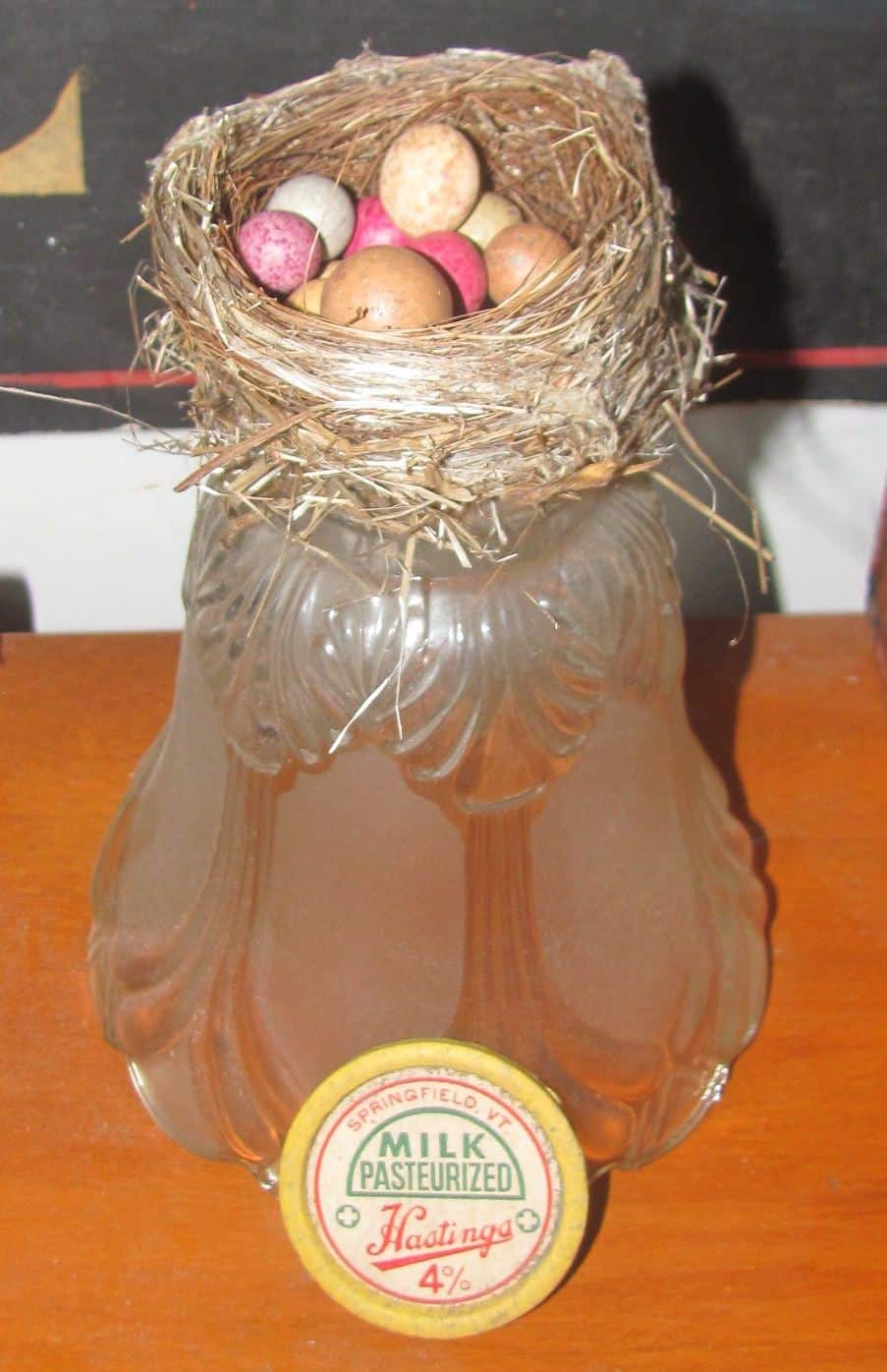
Of my many interests, Mother Nature ranks at the top. Ever since I was a kid I’ve always picked up bird nests or feathers I found. I have a few feathers I’ve kept, along with a few bird nests. The question has always been how to display them. They are ephemeral at best.
The photo with this article is one of my creations. The glass base is an antique lamp shade. On top is a tiny bird nest. The eggs you see are antique clay Bennington marbles.
I love putting little things like this together. This display makes me smile. At the bottom of the glass shade is a cardboard milk bottle cap. It’s from Hastings Dairy in Springfield. We’ll get to Hastings Dairy in a bit.
The bird nest is very small and made of fine grasses intricately woven together. It very much resembles basket weaving. It’s no more than two and a half inches in diameter, and weighs almost nothing.
The glass shade is 100 years old. Part of the glass is frosted while other parts are molded. I’m sure many will have seen these shades. They no longer sell but I still pick them up when I see them.
In the antiques trade these marbles are referred to as Bennington marbles. No doubt other 19th century potters produced them. They are made of clay and of different diameters. They have an unglazed surface and come in many colors. By themselves they are not much to look at, but in the nest they are fun.
Hastings Dairy
Several years ago I interviewed Marion Harlow of North Springfield. Marion was 100 at the time. We talked about her memories of the old days. I remember her telling me about Hastings Dairy. Hastings Dairy was on Union Street very close to what is Union Street School today.
I remember Marion telling me about the day Charles Lindberg landed at the North Springfield airport in 1927. Marion said Hastings Dairy was at the airport selling ice cream.
I called Hugh Putnam about Hastings Dairy. He agreed it was near the school. And Springfield Historical Society has two Hastings milk bottles and some of the cardboard bottle caps. Hastings milk bottles have always been desirable with milk bottle collectors.
Ted Spaulding remembered doing some electrical wiring in the Hastings building in the early ’50s. By then Hastings had been bought out by Idlenot Dairy. Ted mentioned the hardening room. I asked what that was. It was the cold room for ice cream. Ted said it was -28 degrees below zero. Ted said Frank Kendall worked in the cold room and that he wore a fur coat to keep warm.
The Hastings bottle cap pictured reads: “SPRINGFIELD, VT MILK PASTURIZED Hastings (in script) 4%” I think today whole milk is 3%. Hastings 4% milk would have been creamier.
Rufus Estey Dairy
I also have a Rufus Estey bottle cap. Estey Dairy was on RT 143, or Skitchewaug Trail as I know it. Past the Springfield Humane Society the road curves to the right. If you went straight instead of taking the curve you would be in Eureka. Keep to the right. The first building on the left was Estey Dairy when I was a kid. I don’t know what it is today.
Some dairies processed only milk from Holsteins, Jersey’s, or other breeds. I don’t always trust my memory but I seem to remember Estey used milk from Jersey cows. Jersey milk has a higher butterfat content than say Holsteins. But Holsteins produce more milk than Jerseys do.
Because I love the natural world I have a number of other interesting items. I have a couple of the paper-like wasp nests. They can be quite large although mine are smaller. When I was 14 out hiking in the woods one cold winter day I found a wasp nest fastened to a low hanging branch. I broke the limb off and brought the nest home.
My mother had an antique secretary with glass doors on top. Ma kept a few china dishes and such in the top section. I opened the doors and put the large wasp nest on a shelf. A couple hours later I went to admire my new acquisition. Imagine my surprise to see the inside of the glass doors covered with crawling wasps. I didn’t gain any points that day.
This week’s old saying is from Henri Rousseau: “Nothing makes me so happy as to observe nature and paint what I see.”